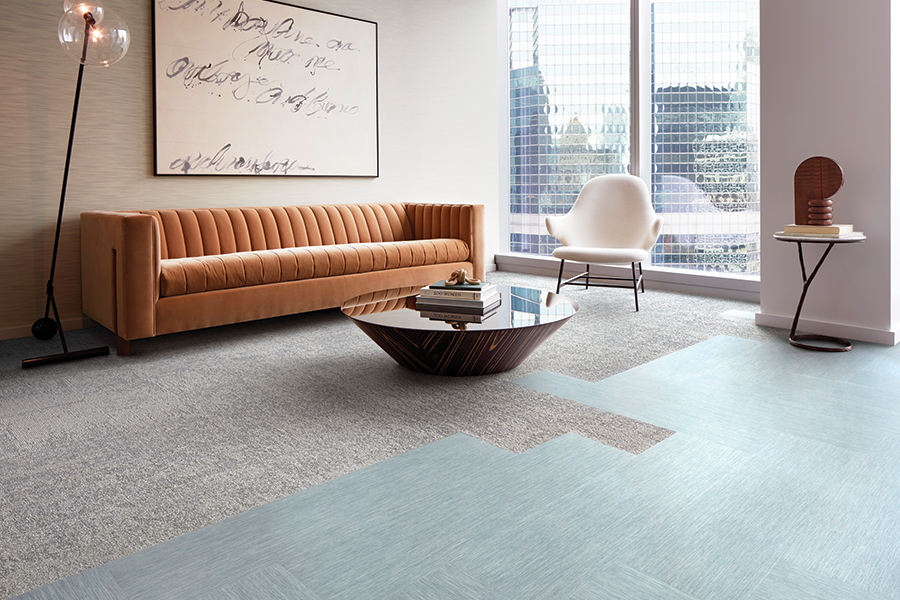FLOORING has an important part to play in making the built environment more sustainable which is imperative to the UK hitting its net zero target in 2050. Although imagining a sustainable future for their operations can be daunting for contractors, specifiers and manufacturers already navigating difficult economic and industry conditions, it is possible. But where to start?
The familiar position of knowing things need to change but not being sure where to start is where Interface found itself in the early 90s, as our founder Ray Anderson sought to find an answer to what the company was doing for the environment. Cut to 2023 and Interface is now a Carbon Neutral Enterprise, and we have set our sights on becoming a carbon-negative business by 2040 with our Climate Take Back mission.
Getting this far has meant navigating some steep learning curves and taking a broad look at the impact of our products and wider company. It won’t be long before the need to reduce carbon footprint becomes mission critical for businesses across the sector, and we hope that Interface’s experience can be a useful guide to getting started.
Knowledge is power
Meaningful change requires meaningful metrics, so the first step for any business looking to work more sustainably is understanding its current emissions. This doesn’t just mean measuring the emissions that result directly and indirectly from operations and energy (known as Scope 1 and Scope 2 emissions), but those from other indirect emissions such as how products are used and disposed of (Scope 3).
For flooring, this means undertaking lifecycle assessments that measure the impact of the product from manufacturing through installation, use and disposal. Many companies focus on their Scope 1 and 2 emissions, which is a good starting point, but in the majority of cases, a significant proportion of a company’s emissions will be Scope 3.
For Interface, understanding the full lifecycle carbon footprint of our products was critical as a significant amount comes from the raw materials we use, maintenance of the installed product, and the end of life.
Once we have this understanding of our carbon footprint, we can set targets and begin the process of carbon reduction. In 2022, Interface took the huge step of balancing our entire carbon footprint and became a carbon neutral enterprise, meaning any impact created by our products and company is offset to zero. This was only possible through measurement and reductions achieved since we started our first sustainability mission in 1994.
Having a comprehensive view of their emissions allows businesses to understand their impact and where they might be able to make the most significant changes. It also creates transparency, assuring customers and employees that progress is being made and there are robust plans for future reductions.
Reduce, reduce, reduce
Having interrogated their current impact and defined their objectives, companies can get to work on reducing their footprint. At Interface, one of our key areas to address was the raw materials being used in our products.
Continual innovation has led to more recycled and biobased content being used in our products and our latest innovation, CQuestBio backing, is cradle-to-gate carbon negative. This means it stores more carbon than it releases, and it comes as standard on all our carpet tiles, not just certain collections. This has enabled our customers to lower the carbon footprint of the projects they’re working on, reducing their Scope 3 emissions.
Alongside the headline-making innovations such as switching to renewable energy and recycled materials, product design and installation adjustments are also needed, which often require a smaller upfront investment and have an immediate impact. Training installers to reduce waste during the fit-out process, as well as providing more sustainable adhesives, brings down Scope 3 emissions that we’re often too quick to declare out of our reach.
There’s a certain amount of pragmatism required; a frank approach that goes beyond how sustainable a product is on paper. One of the most important things we’ve learned when designing for sustainability is the need to balance environmental benefits with performance and durability – a ‘sustainable’ floor that needs replacing every three years isn’t that sustainable.
We’ve also seen the value of giving our partners the tools to make better choices with our products when they’re replacing flooring. Introducing take back options gives users direct access to sustainable disposal.
Interface’s ReEntry programme gives carpet tiles a new lease of life with worthy causes in the local community, eliminating the emissions created by producing something new.
Sharing is caring
A sustainable flooring industry will be built on a culture of transparency. Environmental impact is already front of mind for customers, who are becoming more fluent with the language and metrics of sustainability. Businesses looking to thrive in this market will need to make the details of their products available and digestible.
In the built environment, we are seeing the increase in demand for environmental product declarations, which provide transparency on the carbon footprint of the product and allow specifiers and contractors to compare different solutions.
This desire for transparency will move beyond products alone – soon, customers will want to know what manufacturers and contractors are measuring and what steps they’re taking to reduce their impact and footprint. This is where external verification will become increasingly important to ensure that targets set are in line with what is required, and any offsets used are making a real, additional and measurable reduction.
For the flooring sector, it’s a question of when rather than if the industry will be forced to work more sustainably. For many businesses, how they manage the transition will be crucial to how they fare in a future defined by a more sustainable built environment. It’s easier said than done, and there are no shortcuts, but it is possible, and we have a duty to make it happen.
www.interface.com
Becky Gordon is regional sustainability manager (ukime), Interface
Please click to view more articles about
> Interface <

